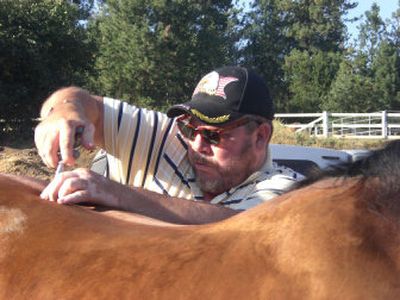Horse chiropractor has the touch

Aching, creaky back got you sidelined from your favorite activities or work? Imagine being a 1,200-pound horse with an achy back who’s being asked to run, jump and spin all while carrying a 150-pound human.
Joe Fitzpatrick knows how to take care of that problem. He’s an equine chiropractor who has been helping horses, or anything with a spine for that matter, move freely for more than 27 years.
Chiropractic care for horses is much like that for humans. It involves maintaining the proper function of the spinal column, including providing a strong framework of support for the body. With active, working horses, it can be critical to their continued success.
All this for a horse may seem crazy to some but Jackie Easterling knows that it works. Easterling, who owns Elliott, a big paint gelding, is a believer.
“I just felt something. Elliott’s gait was off,” Easterling said. “We were walking and it would be like he’d get a hitch in his get-along, sort of dragging his toes.”
Easterling called Fitzpatrick, who came out to Flaherty Ranch, where Easterling keeps Elliott. He watched Elliott walk around, then went to work.
“Most people aren’t aware that their horse may be out until they are really out,” said Fitzpatrick as he talked about how long it takes someone to realize a chiropractor may be the person to call.
Elliott was in pain on that first visit and Easterling recalled that Elliott jumped straight up with pain, “off his toes, like a cat” when Fitzpatrick first examined him.
On the second visit, Fitzpatrick added neck adjustments to help Elliott to regain his flexibility.
“Remember how much pain this guy was in when I first worked on him?” Fitzpatrick asked Easterling.
“Now Elliott’s suppleness is much better, much different. Now he just doesn’t hurt,” Easterling said.
Fitzpatrick has seen a lot of horses come and go during his life.
“I went to school for six years to become a chiropractor,” he said, “but I’ve been a horseman all my life.
Fitzpatrick started working on horses in 1980 when he was at a racetrack with a horseman named Troy Ferris.
“He was a real old-time cowboy sort, a real poker player who wore a derby hat everywhere,” said Fitzpatrick, “He said Joe, we got to get to the bottom of these horse’s backs.”
Fitzpatrick started right then with a big red horse, all 1,800 pounds of him.
“I worked on him several times over the next two weeks. He was a 50-1 long shot in the next race he was entered in. But he won easy, it made a big difference,” Fitzpatrick recalled.
From that point on the word was out. By the end of that summer Fitzpatrick had worked on approximately 200 horses.
“I helped the majority of them, you can’t always fix all of them, but I helped the majority of them,” he said.
Steve Flaherty has been around horses just as long as Fitzpatrick. He’s the owner of Flaherty Ranch and a breeder of American quarter horses.
“I believe that anything that helps the athlete do what they do better is good because we ask so much of them,” said Flaherty. “I don’t understand how it works, but I do know it works.”
One of the animals Fitzpatrick helped was Flaherty’s 14-year-old Labrador retriever mix, Roxy, who was showing signs of age and hip problems.
“She came up to me and kept nudging me with her head while I was working with the horses, she just kept nudging until I finally looked at her and told Steve that his dog was trying to tell me she needed help. Then I just adjusted her back a little bit on a couple of visits,” Fitzpatrick said.
“Now she’s moving a lot better, she doesn’t have any problem getting up and she used to kind of have a hard time with her hip,” agreed Flaherty.
“I wish that people would get away from being so naïve about what kind of care would help their horses because there are so many more that would benefit,” Fitzpatrick said.
Once he discovers what particular issues a horse, or other animal, is having, Fitzpatrick goes to work. He insists that a horse has an initial three visits so that he can really help the animal progress. After the first three visits, and depending on the horse’s response, Fitzpatrick will cut back to a maintenance visit scheduled when needed.
Just like humans, there are a number of signs that can indicate your horse may benefit from chiropractic care, including stiffness, irritability, trauma and reluctance to work. Unlike humans, a horse isn’t able to tell us he wants to call in sick because his back is out.